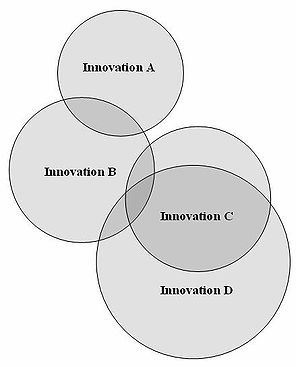
Wave model (linguistics)
Encyclopedia

Historical linguistics
Historical linguistics is the study of language change. It has five main concerns:* to describe and account for observed changes in particular languages...
, the wave model or wave theory (German
German language
German is a West Germanic language, related to and classified alongside English and Dutch. With an estimated 90 – 98 million native speakers, German is one of the world's major languages and is the most widely-spoken first language in the European Union....
Wellentheorie) is a model of language change in which new features of a language spread from a central point in continuously weakening concentric circles, similar to the waves created when a stone is thrown into a body of water. According to the model, this should lead to convergence among dissimilar languages. The theory was directed against the doctrine of sound laws and the strict tree model
Tree model
A language tree, or family tree with languages substituted for real family members, has the form of a node-link diagram of a logical tree structure. Additional linguistics terminology derives from it. Such a diagram contains branch points, or nodes, from which the daughter languages descend by...
introduced by the Neogrammarian
Neogrammarian
The Neogrammarians were a German school of linguists, originally at the University of Leipzig, in the late 19th century who proposed the Neogrammarian hypothesis of the regularity of sound change...
s and laid the foundations of modern sociolinguistics
Sociolinguistics
Sociolinguistics is the descriptive study of the effect of any and all aspects of society, including cultural norms, expectations, and context, on the way language is used, and the effects of language use on society...
. Advocacy of the wave theory is attributed to Johannes Schmidt
Johannes Schmidt (linguist)
Johannes Friedrich Heinrich Schmidt was a German linguist. He developed the Wellentheorie of language development.-Biography:Schmidt was born in Prenzlau, Province of Brandenburg...
and Hugo Schuchardt
Hugo Schuchardt
Hugo Ernst Mario Schuchardt was an eminent linguist, best known for his work in the Romance languages, the Basque language, and in mixed languages, including pidgins, creoles, and the Lingua franca of the Mediterranean.-In Germany:Schuchardt grew up in Gotha...
.
In modern linguistics, the wave model has contributed greatly to improve the tree model
Tree model
A language tree, or family tree with languages substituted for real family members, has the form of a node-link diagram of a logical tree structure. Additional linguistics terminology derives from it. Such a diagram contains branch points, or nodes, from which the daughter languages descend by...
approach of the Comparative method.

